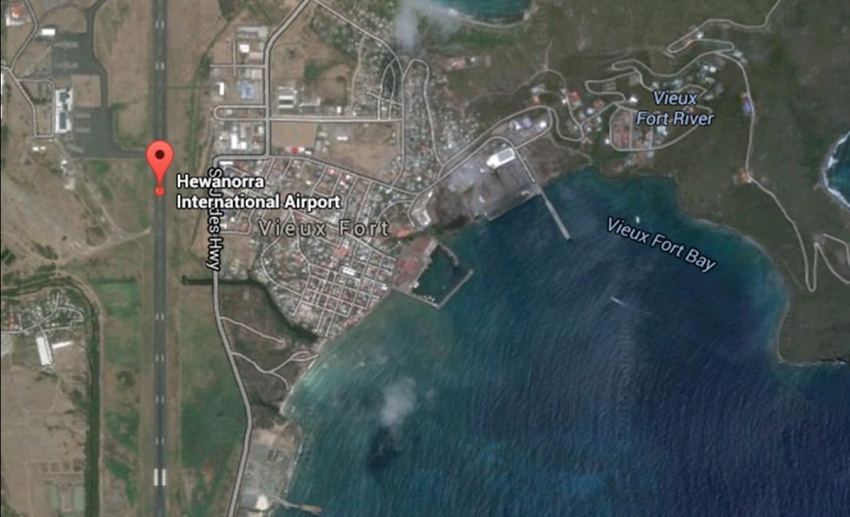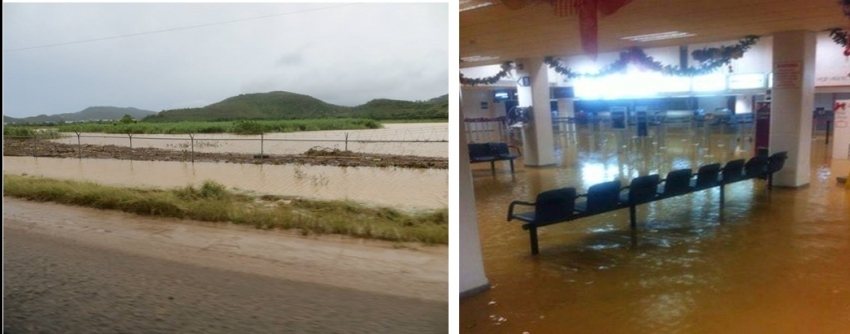| Before you start: | Use case Location: | Uses GIS data: | Authors: |
|---|---|---|---|
| Section 3.3.1 Landslide mitigation measures for buildings section 3.3.2 Flood mitigation measures for buildings can be read before this use case | This use case is Illustrated with the flood protection works required from the Hewanorra International airport, Saint Lucia, and the works required for protecting the city center of Castries, and works needed for Belize City | No |
Naveed Anwar, Mark Brussel, Mark Trigg |
Introduction:
It is important to identify the assets and facilities that are critical to the functioning of the important operations and provision of essential services, and vulnerable to hazards. It is also important to determine the resulting consequences to those assets and to overall utility operations. Critical infrastructure must be designed, located, and sufficiently protected to remain operational during hazards. Multiple Hazards should be considered while preparing mitigation plan for critical Infrastructure as they provide essential services to daily life and of vital importance to public wellbeing such as drinking water supply, power supply, waste water disposal sites, water treatment plants, and transportation hubs.
Tourist sites and infrastructure should also be considered, both in terms of protecting points of interest for tourists in the islands(e.g. waterfalls, hot water springs), and tourists trails.
For example for the flood hazard, recent FEMA and ASCE publications recommend elevating critical infrastructure above the 500-year flood (i.e. 0.2% annual flood event) elevation, if feasible, carry out flood proofing or prevention.
In the context of critical infrastructure, hazard resilience also refers to:
- coordinated planning across sectors and networks
- responsive, flexible and timely recovery measures, and
The development of an organisational culture that has the ability to provide a minimum level of service during interruptions, emergencies and disasters, and return to full operations quickly (1).
Scenario based planning can be good option in assessing whether organisations have developed an adequate resilience capacity for critical infrastructures.
Objectives:
The objectives on which this use case is based upon are:
- Consider flooding as the potential hazard and risk for the critical infrastructure
- Provide focus on mitigation works to protect other critical infrastructure, such as water supply, hydro-power dams, airports, water treatment plants, waste disposal sites etc.
Emphasize on protecting tourist sites and infrastructure, both in terms of protecting points of interest for tourists in the islands (e.g. waterfalls, hot water springs, and tourist trails (e.g. Domincia and Saint Vincent)
Flowchart:
The critical infrastructure could be spread on fairly large area. However, not all part of the infrastructure may be critical both in terms of the requirements for the functionality of infrastructure facility, or for hazard to the occupants or the services.
The following overall flow chart can be used as a guideline for determining and implementing the protection from floods and its consequences.

Use case study area description:
The Hewanorra International Airport terminal building, also located in Vieux Fort, was badly flooded and debris accumulated on the runway in 2013.


Problems definition and specifications:
The measures and steps needed to protect the essential infrastructure other than building from the flood hazard and minimizing potential consequences of flooding of these facilities.
- Facility plans and details
- Flood risk maps
Analysis steps: A- Identify the critical Part of the facilities based on the functioning, contents, building type, and its role in the overall infrastructure. B- Determine the risk of flooding as well as the consequences of flooding to the operation of the facility, safety of its occupants and possible impact on the environment of the area as consequences of flooding. Consider the elevation, location, building characteristics and other vulnerability factors during this assessment. C- Determine the suitablility of protection measures which may include individual or combination of the following:
- Site measures
- Local facility/ building measures
The site measures may include:
- Diversion of water away from the facility
- Drainage around and within facility either leading to gravity outlets or storage and pumping facilities
- Construction of dykes and other levy walls or other similar protection or water barriers
- Construction of flood plains/ retention ponds around or within the facility
The measures within the site for various facilities and buildings may be based on the section 3.2.1 Buildings of Use Case book.
Results:
The mitigation work plan should be revisited periodically and mitigation measures that involve major capital and infrastructure investments should be integrated into the utility's overall scheduling in the asset management planning process (e.g., phasing in flood-resistant pumps).
Water and wastewater utilities are particularly vulnerable to flooding. Flood water and debris can inundate the facility and can lead to various consequences specifically disruptions of services, and hazardous situations for personnel and public health advisories.
It is also necessary to analyse how drinking water or wastewater utility may be impacted by hazardous events so that appropriate mitigation measures can be identified to eliminate or reduce asset damage and prevent service disruptions
|
Critical Infrastructures |
Parts of Critical Infrastructures |
Possible Mitigation Measures |
|---|---|---|
|
Airport |
Overall Site |
|
|
Terminal Buildings |
|
|
|
Cargo building |
|
|
|
Access roads |
|
|
|
Water Supply |
Overall Site |
|
|
Water intake Distribution and storage |
|
|
|
Booster stations and other pumps |
|
|
|
Drinking water treatment plants |
|
|
|
Electrical controls and supply |
|
|
|
Hydro Power Dams |
Dam |
|
|
Power House (Generator. Transformers), Turbines |
|
|
|
Power lines |
|
|
|
Control Gates |
|
|
|
Water treatment Plants |
Overall site |
|
|
Lift Stations |
|
|
|
Head works |
|
|
|
Waste water treatment plants |
|
|
|
Electrical controls and supply |
|
|
|
Waste Disposal Sites |
Overall site |
|
|
Hazardous waste zone |
|
|
|
Tourist Sites (Islands) |
Waterfalls and hot water springs |
|
|
Tourists trails |
|
References:
(1) Council of Australian Government's Senior Officers' Meeting Review of National CIP Arrangements, Final Report 2009
[1] http://www.weather-forecast.com/weather-stations/Hewanorra-International-Airport-1
Last update: 01 - 01 - 2015

